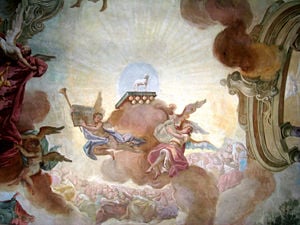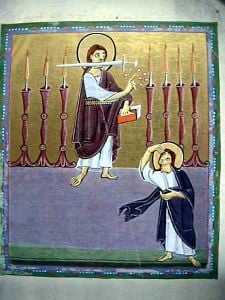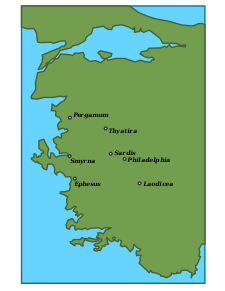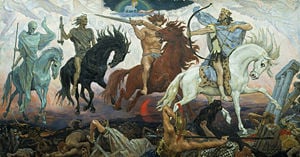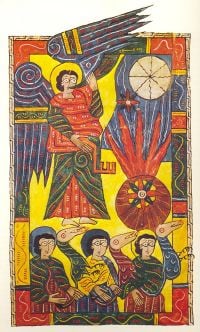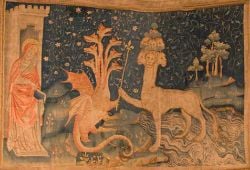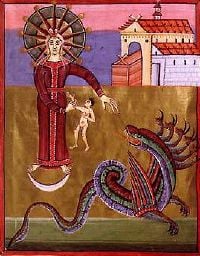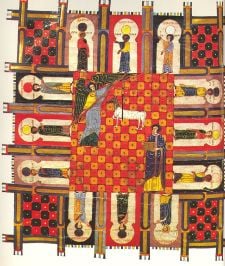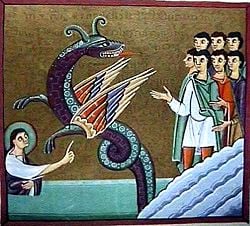Book of Revelation
| New Testament |
|---|
The Book of Revelation, also called Revelation to John or Apocalypse of John, is the last canonical book of the New Testament in the Christian Bible. It is the only biblical book that is almost wholly composed of apocalyptic literature. Other apocalypses popular in the early Christian era did not achieve canonical status, although 2 Esdras (The Apocalypse of Ezra) is canonical in the Russian Orthodox and Ethiopian Orthodox Churches.
Revelation is composed of two main sections. The first is a message to the churches of seven cities in the Roman province of Asia, urging them to endure persecution and repent of their sins. The second is an apocalyptic unveiling of the Last Days, including such memorable visions as the Four Horsemen of the Apocalypse, the trumpet calls of seven angels signaling terrible catastrophes for mankind, the Beast whose number is 666 and his False Prophet, the woman pursued by a dragon and her child who is caught up to heaven, the Harlot of Babylon, the Battle of Armageddon, the Final Judgment, the millennial reign of Christ and the saints, the Marriage Supper of the Lamb, and the descent of the New Jerusalem. The book concludes with a promise from Jesus that he is "coming soon."
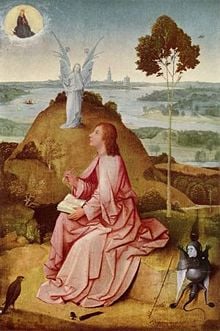
The Book of Revelation has produced many interpretations and much speculation. Many consider it a prophecy predicting what will happen prior to the Second Coming. Indeed, nearly every age has witnessed movements which believe that the prophecies of John were coming to pass and that the Last Days were at hand. Others increasingly take the view of historical criticism, that Revelation was written mainly to inspire first century Christians to resist persecution, in the expectation that Christ would be returning immediately. Still others consider it the work inspired more by hysteria than true prophecy. Thomas Jefferson, for example, called it "the ravings of a maniac." It remains one of the most widely known books of the Bible because of its vivid imagery and its prophecies of both doom and hope.
Introduction
The book is frequently called "Revelation;" however, the title found on some of the earliest manuscripts is "The Apocalypse (or Revelation) of John," and the most common title found on later manuscripts is "The Apocalypse/Revelation of the theologian."[1] Many people mistakenly call the book "Revelations" or "The Book of Revelations" due to the long series of apocalyptic events which unfold throughout the manuscript. The first sentence of the book, The Revelation of Jesus Christ… unto his servant John, is also sometimes used as a title.
The book presents a dramatic account of two visions received by the author, John, on the isle of Patmos. The first vision (1:11–3:22), is a message from "one like unto the son of man, clothed with a garment down to the foot, and girt about the paps with a golden girdle," speaking with "a great voice, as of a trumpet." It is addressed to the "angels" of the seven churches of Asia, meaning Asia Minor, in today's Turkey. The second vision, which makes up the rest of the book (4–22), begins with "a door… opened in the sky" and describes the end of the world—involving horrifying wars, famines, plagues, natural disasters, fantastic creatures, mass martyrdoms, harsh punishments from God, and the great battle at Armageddon, the final defeat of Satan, Second Coming of Christ, and the establishment of God's kingdom of peace.
In the fourth century, St. John Chrysostom and certain other bishops argued against including Revelation in the New Testament canon, chiefly because of the difficulties of interpreting it and the danger for abuse. Christians in Syria rejected it because of the heretical Montanists' heavy reliance on it. By the fourth century, however, it was included in the accepted canon, although it remains the only book of the New Testament that is not read within the Divine Liturgy of the Eastern Orthodox Church.
Revelation is one of the most controversial and difficult books of the Bible, with many diverse interpretations of the meanings, characters and events in the account. In the ninth century, it was included with the non-canonical Apocalypse of Peter among "disputed" books in the Stichometry of St. Nicephorus, Patriarch of Constantinople. Protestant founder Martin Luther at first considered Revelation to be "neither apostolic nor prophetic" and stated that "Christ is neither taught nor known in it."[2] Luther later accepted it, along with several other New Testament books he initially rejected. John Calvin, on the other hand, always believed the book to be canonical; yet it was the only New Testament book on which he did not write a commentary.[3]
Modern critical scholarship tends to view Revelation as deriving from Jewish apocalyptic literature, especially the Book of Daniel, from which it borrows freely. They often see it, like Daniel, as having been written basically to encourage resistance to an oppressive power, in this case Rome.
Religious skeptics have often been highly critical of Revelation, sometimes considering it the work of a mentally ill author. Typical in this vein is nineteenth-century agnostic Robert G. Ingersoll, who famously branded Revelation "the insanest of all books."[4]
Authorship
The traditional view holds that John the Apostle—considered to have written the Gospel of John and Epistles of John—was exiled on Patmos in the Aegean archipelago during the reign of Emperor Domitian, and wrote the Book of Revelation there. Those in favor of a single common author of the Johannine literature point to similarities between the Gospel of John and Revelation. For example, both works are soteriological (e.g. referring to Jesus as a lamb) and possess a high Christology, stressing Jesus' divine side as opposed to the human side stressed by the Synoptic Gospels. In both the Gospel of John and in Revelation, Jesus is referred to as "the Word of God" (Ő λογος του θεου). Explanations of the differences among John's supposed works include factoring in underlying purposes, the target audience, the author's collaboration with or utilization of different scribes, and the advanced age of John the Apostle when he wrote Revelation.
A number of Church Fathers express an opinion on the authorship of Revelation. Justin Martyr avowed his belief in its apostolic origin. Irenaeus (178 C.E.) assumed it as a conceded point. At the end of the second century, it was accepted at Antioch, by Theophilus, and in Africa by Tertullian. At the beginning of the third century, it was accepted by Clement of Alexandria and by Origen, later by Methodius, Cyprian, and Lactantius. Dionysius of Alexandria (247 C.E.) rejected it, upon doctrinal rather than critical grounds. Eusebius (315 C.E.) suspended his judgment, hesitating between the external and internal evidence. Some authorities, especially in the Eastern Church, rejected the book, however.
Although the traditional view still has many adherents, many modern scholars believe that John the Apostle, John the Evangelist, and John of Patmos refer to three separate individuals. They point to several lines of evidence suggesting that "John of Patmos" wrote only Revelation, not the Gospel of John nor the epistles of John. For one, the author of Revelation identifies himself as "John" several times, but the author of the Gospel of John and the writer of the epistles of "John" never identify themselves by name. Also, while both the Gospel of John and the Book of Revelation liken Jesus to a lamb, they consistently use different words for lamb when referring to him — the Gospel uses amnos, Revelation uses arnion.[5] Lastly, the Gospel of John is written in nearly flawless Greek, but Revelation contains grammatical errors and stylistic abnormalities which indicate its author was not as familiar with the Greek language as the Gospel's author.
Date
According to early tradition, the writing of this book took place near the very end of Domitian's reign, around 95 or 96. Others contend for an earlier date, 68 or 69, in the reign of Nero or shortly thereafter.[6] The majority of modern scholars also use these dates.
Those in favor of the later date appeal to the external testimony of Irenaeus (d. 185), who stated that he had received information about the book from those who had seen John face to face. He says that the Apocalypse "was seen no very long time since, but almost in our day, toward the end of Domitian's reign" (A.H. 5.30.3). According to Eusebius of Caesarea, Domitian had started the persecution referred to in the book. Many scholars agree that the number 666 identifying the "Beast" of Revelation refers to Nero; however those favoring a late date see this reference as an allegory, with Nero symbolizing a later tyrant, whether Domitian or someone else. Some experts believe the work was not written all at one time, with several editors having a hand in bringing it to its present form. The dating of the work is still widely debated in the scholarly community.
Summary
The first three chapters of the Book of Revelation contain a channeled message from Jesus through John, to the seven churches of Asia. The remaining chapters present a series of events, full of imagery and metaphor, which detail the chronology of God's judgment on the world.
Letter to the Seven Churches
The book identifies itself as the "revelation of Jesus Christ" given to "his servant John," who bestows a blessing on those who read, hear, and take to heart its prophecy, because "the time is near." It then takes the form of an epistle from John to the seven churches of the Roman territory of Asia. John states that he was on the island of Patmos when he heard a voice commanding him to deliver this message to the churches at the following cities: Ephesus, Smyrna, Pergamum, Thyatira, Sardis, Philadelphia, and Laodicea. The speaker is "one like the son of man," a magnificent spiritual being who is described in impressive detail. Before him stand seven golden lampstands, representing the angels of the seven churches. "In his right hand he held seven stars, and out of his mouth came a sharp double-edged sword. His face was like the sun shining in all its brilliance." (Chapter 1)
To the church at Ephesus, the heavenly speaker begins with words of praise for its hard work and perseverance. He shares the church's hatred of the heretical Nicolaitans, a group traditionally believed to have practiced sexual promiscuity in the name of Christianity. However, the speaker criticizes the Ephesians for having "forsaken your first love," and he threatens to remove it from its place of honor among the churches if it does not repent. For the church at Smyrna he predicts suffering and persecution, but praises the church for its previous perseverance in the face of slander from the local Jewish community, whom he refers to as "those who say they are Jews and are not, but are a synagogue of Satan." To the church at Pergamum he follows the pattern of beginning with praise for its suffering, but follows with criticism for not being stricter with those who "sin by eating food sacrificed to idols and by committing sexual immorality," even allowing membership to those who hold to teaching of the hated Nicolaitans. To the church at Thyatira, he professes his love, but condemns the church for its toleration of "that woman Jezebel," a prophetess who leads people into "sexual immorality and the eating of food sacrificed to idols." (chapter 2)
For the church at Sardis, the speaker has no kind words, accusing it of being spiritually dead. He admits only that "Yet you have a few people in Sardis who have not soiled their clothes," and calls the church at large to repent, lest he come as "a thief" and blot their names from the Book of Life. In contrast, to the church at Philadelphia, he gives only encouragement; it is weak but it has endured. He promises that those of the "synagogue of Satan" will bow before the Philadelphian Christians, and assures them "I am coming soon." Finally he speaks to the Laodiceans, calling them "lukewarm" on account of their wealth and comforts. He threatens to "spew you from my mouth" because of their lack of zeal, and urges them to repent.
Each of the churches receives a promise of a reward for those who persevere, relating either to participating in the blessings or avoiding the "woes" described in the succeeding chapters.
The Seven Seals
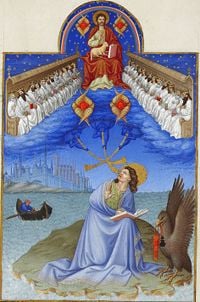
The book now turns to a very different type of revelation. The vision opens with a detailed description of a divine being who has placed an "open door" before the revelator. "Come up here," a voice declares, "and I will show you what must take place after this." God—having the appearance of "jasper and carnelian"—sits on a throne encircled by a rainbow, surrounded by 24 elders. Thunder and lightning issue from the throne, before which are seven lamps described as the "seven spirits of God" and four winged "living creatures" covered with eyes, apparently seraphim. (Chapter 4)
Next to the throne of God is a scroll sealed with seven seals, which may only be opened by "the Lamb," a being with seven horns and seven eyes, who is worshiped by the elders, by the "living creatures," and by myriads of angels, who declare him "worthy" to open the scroll because "you were slain, and with your blood you purchased men for God." (Chapter 5) The Lamb opens the first four seals they reveal the Four Horsemen of the Apocalypse, riding a white horse symbolizing one who conquers, a red horse symbolizing war, a black horse symbolizing famine, and a pale green horse symbolizing death. The opening of the fifth seal reveals the souls of the martyrs who had been slain "because of the word of God," who cry out that God should soon "avenge our blood." They are told to be patient, because more martyrs must still join them before the day of vengeance arrives. When the sixth seal is opened, "the sky receded like a scroll, rolling up, and every mountain and island was removed from its place." The wealthy rulers of the world, as well as the poor and slaves alike, all flee and seek to hide from "the wrath of the Lamb." (Chapter 6)
Terrible natural calamities are about to occur, but angels restrain them until 144,000 saints can be "sealed," 12,000 from each of the tribes of Israel. The revelator is informed that these are "they who have come out of the great tribulation; they have washed their robes and made them white in the blood of the Lamb." (Chapter 7) Now the seventh seal is opened, and a "silence in heaven" ensues for half an hour. Seven angels appear, each with a trumpet. The sounding of the first trumpet brings "hail and fire mixed with blood," destroying one third of the earth. The second trumpet signals the death of one third of the sea creatures. The third brings the poisoning of the fresh waters, causing many people to die. The fourth trumpet results in a third of the sun, moon, and stars losing their light. The worst, however, is yet to come, as eagle flies through the air declaring: "Woe! Woe! Woe to the inhabitants of the earth, because of the trumpet blasts about to be sounded by the other three angels!" (Chapter 8)
The three woes
The first "woe"—proclaimed by the trumpet of the fifth angel—is a star which falls to earth and opens an abyss. Terrible smoke and fire arise, causing the sun to be darkened and allowing hordes of horse-sized locusts to escape. These monsters have scorpion-like stings, human faces, lions' teeth, and women's hair, and they will torment the inhabitants of the earth for five months, excepting only the 144,000 who have been sealed. The sixth angel's trumpet signals the release of four mighty angels of war from the River Euphrates, with a force of 200 million mounted troops; their mission: "to kill a third of mankind." However, even this does not cause the rest of mankind to turn to God, "nor did they repent of their murders, their magic arts, their sexual immorality or their thefts." (Chapter 9)
At this point a new angel intervenes, descending from above and standing on both the sea and the land. He provides the revelator with a small scroll that he must eat, for: "You must prophesy again about many peoples, nations, languages and kings." (Chapter 10) The revelator is instructed to measure the Temple of Jerusalem. Gentiles will trample the holy city for 42 months, but two "witnesses"—called two olive trees—will be given divine power to testify during this time. Fire comes from their mouths to devour their opponents and there is no rain at all during their ministry. A beast will arise from the abyss and kill them, and the inhabitants of the earth will rejoice because of the torments these prophets brought. However the two witnesses will revive after three and a half days. A terrible earthquake ensues as the witnesses ascend into heaven, and 7,000 people are killed. This concludes the "second woe."
Finally, the seventh trumpet is sounded, and great rejoicing is heard in heaven, as "the kingdom of our Lord and of his Christ" is inaugurated. God's temple in heaven is opened, and the Ark of the Covenant is revealed, among "flashes of lightning, rumblings, peals of thunder, an earthquake and a great hailstorm." (Chapter 11)
Suddenly a woman of great royalty appears, pursed by a dragon. She is to give birth to a child who will rule the world with an iron rod, but her child is caught up to God, and she flees to the desert, where she will remain for 1,260 days. Now the Archangel Michael and his angels make war against Satan, who is cast down to earth. This "ancient serpent" now turns to pursue the woman, but she escapes on an eagle's wings, while the dragon contents himself to make war on the saints. (Chapter 12)
A terrible beast now emerges from the sea, with ten horns and seven heads, resembling a leopard. For 42 months, he is given authority over the earth, uttering blasphemous words against God. He has a fatal wound, but it has been healed, and everyone except the 144,000 worship him. Now another beast emerges from the earth, this one with "two horns like a lamb, but he spoke like a dragon." He has the power to work miracles, and it is he who influences the people to worship the first beast. This beast breathes life into the first beast's image and causes all people to receive a mark on their forehead in order to buy or sell. The number of the beast and of his mark is 666. (Chapter 13)
A vision now intervenes of the 144,000 saints, with three angels who predict the ultimate triumph of God. A man "like the son of man" sits on a white cloud. He is commanded by an angel to "Take your sickle and reap" the earth. An angel joins him in this work, and grapes are harvested into "the great winepress of God's wrath," reaching a height of 180 miles. (Chapter 14) Seven more angels appear, each of them with a plague. God's heavenly temple remains closed while the angels do their work. (Chapter 15) God commands the seven angels to pour out his wrath on the earth:
- Sores break out on the people who have the mark of the beast and worship his image.
- The sea turns to blood and everything in it dies.
- The rivers also turn to blood, and the angel in charge declares God's judgment just.
- The sun scorches the people of the earth with fire, and the people still do not repent.
- The kingdom of the beast is plunged into darkness; the people only curse God all the more.
- The Euphrates runs dry in preparation for the coming war of Armageddon.
- The most terrible earthquake causes "the great city" to be split into three parts, and the cities of the nations collapse; hailstones weighing 100 pounds fall to earth with crushing force. (Chapter 16)
An angel now shows the revelator the punishment which will be given to the "Harlot of Babylon," who is responsible for the suffering of God's saints and rides on the beast with seven heads and ten horns. The heads are seven hills and also seven kings. The beast himself is also a king. The ten horns are also ten lesser kings, who will receive their authority from the beast. Various other clues are given to interpreting the vision of the prostitute, the beasts, and other symbols. (Chapter 17)
An angel declares that "the Harlot of Babylon is fallen." Another angel calls the people of God to come out of her and not to share in her sin. Terrible woes will be added to those who do not repent, but the apostles and prophets will rejoice in the city's suffering. (Chapter 18) A great multitude in heaven sing choruses of "Hallelujah!" as the great wedding feast of the Lamb is declared. A white horse appears, and its rider is declared "faithful and true." His name is the Word of God, and he is the King of Kings and Lord of Lords. The birds are invited to God's feast, where they will "eat the flesh of kings, generals, and mighty men …." The beast and his kings battle with the King of Kings and are defeated. The two beasts (one now called the "false prophet") are "thrown alive into the fiery lake of burning sulfur" while the other kings and their soldiers are "killed with the sword that came out of the mouth of the rider on the horse, and all the birds gorged themselves on their flesh." (Chapter 19)
Satan is now bound and cast into the abyss, where he will remain for 1,000 years. The martyred saints, meanwhile, come to life and reign with Christ. This is dubbed "the first resurrection." After 1,000 years, however, Satan will be released to deceive the people of the earth again. His forces will surround the "city that God loves," but fire will come from heaven and defeat them. This time the Devil and his minions will be tormented in the lake of fire forever, with no escape. Then the final judgment takes place; the Book of Life is opened, and everyone whose name is not found in it will join the Devil in the lake of fire. (Chapter 20)
The New Jerusalem
A great vision of the New Jerusalem now unfolds. It is "prepared as a bride beautifully dressed for her husband," and a voice declares: "Now the dwelling of God is with men." God declares his work finished, promising blessing to those who endure and threatening suffering to those who do not repent of their sins. The New Jerusalem shines with God's glory. It has 12 gates, each with its own angel, for each of the 12 tribes of Israel. Yet it contains no temple, for God and the Lamb are its temple. Nor does it need the sun or the moon, for God provides its light through the Lamb, who is its lamp. The nations walk by this light, and nothing impure ever enters its marvelous gates. (Chapter 21)
A river of life flows through the city from God's throne, and the Tree of Life stands on each side of it, bearing 12 kinds of fruit. Its leaves will heal the nations. The city's citizens will see God's face, and there will be no more curses.
Here the vision breaks off, and Jesus himself speaks again to the churches: "Behold I am coming soon." John bears testimony that he is the one who saw these things. Jesus declares that he has sent his angel to deliver his message to the churches and warns that no one must change anything written in "this book." Again he declares, "Yes, I am coming soon," to which John adds: "Amen. Come, Lord Jesus."
Schools of Thought
There are several schools of thought concerned with how the contents of the Book of Revelation should be interpreted.
- The Biblical prophecy school of thought holds that the contents of Revelation, especially when interpreted in conjunction with the Book of Daniel and other eschatological sections of the Bible, constitute a prophecy of the end times. This school can be further subdivided into the preterist view, which sees the book concerned with first-century events; the futurist view, which applies most of the events in the book into the end times; and the historicist view, which regards the book as spanning history from the first century through the Second Coming.
- The Patristic view, held for example by Saint Augustine, Jerome, and other early Church Fathers, views the Book of Revelation as an attempt to describe a spiritual reality and heavenly worship, related to the liturgy of the Christian Church. Although all but forgotten today, this interpretation is alluded to in the Catechism of the Catholic Church and has been avidly promoted by modern theologians such as Scott Hahn. [7]
- The historical-critical approach, which became dominant among biblical scholars of religion since the end of the eighteenth century, attempts to understand Revelation within the genre of apocalyptic literature, which was popular in both Jewish and Christian tradition since the Babylonian diaspora, following the pattern of the Book of Daniel. In this view, Revelation was created primarily to encourage Christians to repent of their sins and to resist Roman persecution, in expectation of the immediate return of Christ.
- The view of the esoteric schools is that Revelation, like all scriptures, bears seven levels of meaning, the lowest being the literal or "dead-letter." Those who are instructed in the esoteric knowledge enter gradually into more subtle levels of understanding.
- Recently, aesthetic and literary modes of interpretation focus on the book of Revelation as a work of art and imagination, viewing the imagery as symbolic depictions of timeless truths and the victory of good over evil.
- Neo-Ebionites and other Neo-Essenes regard Revelation as related essentially to the Destruction of the Temple of Jerusalem in 70 C.E. and the subsequent Imperial Roman persecution of Jews and Christians.
These schools of thought are not mutually exclusive, and many Christians adopt a combination of these approaches in the manner they find most meaningful. However, certain tendencies may be observed. The Biblical Prophecy is popular among Protestant fundamentalists, and other evangelicals. However, it also characterizes the approach of Rastafarians and other non-Christian or semi-Christian sects. Members of more mainline and liberal churches tend to prefer the historical-critical and aesthetic approaches. Roman and Orthodox churches have defined their own specific positions on Revelation.
There are some notable critics who have dismissed the Book of Revelation as fraudulent, irrelevant, or even the work of a mentally imbalanced person. Among these is Thomas Jefferson, who wrote, "It is between fifty and sixty years since I read it [the Book of Revelation], and I then considered it merely the ravings of a maniac, no more worthy nor capable of explanation than the incoherencies of our own nightly dreams."—-Thomas Jefferson, letter to General Alexander Smyth, January 17, 1825
Significance
No other book in the Christian Bible has produced greater hope or greater fear than the Book of Revelation. Its promise of the immediate Second Coming of Christ and the establishment of the New Jerusalem has led believers in nearly every generation to interpret its symbols as referring to their own time and to see themselves as part of the 144,000 who will resist the power of the Antichrist and reign with Christ for 1,000 years. At the same time, Revelation's vivid descriptions of "woes" and punishments for the vast majority of mankind has led many to despair, as so few seem to be counted among the elect.
In today's Christian world, dozens of groups see Revelation as being fulfilled through their ministries, ranging from fundamentalist preachers, to millennialist sects such as the Jehovah's Witnesses and Seventh Day Adventists, to popular writers of Christian fiction such as Tim LaHaye, and to new religious movements such as the Unification Church. With its rich imagery and symbolism, interpretations of the meaning of Revelation are more diverse than any other biblical text, ranging from its having been fulfilled in the first century, to it pertaining to the distant future, to its being fulfilled in the present day.
Notes
- ↑ The former is found in Codex Sinaiticus and Codex Alexandrinus, among other manuscripts, while the later is found in the Majority Text and others, however a number of other variations of the title do exist. Nestle-Aland. Novum Testamentum Graece, 27th ed. (Druck: Deutsche Bibelgesellschaft, 1996), 632.
- ↑ Luther's Treatment of the 'Disputed Books' of the New Testament www.bible-researcher.com. Retrieved September 10, 2019.
- ↑ Anthony A. Hoekema, The Bible and the future (Grand Rapids: Eerdmans, 1979, ISBN 0802835163), 297.
- ↑ Christopher Rowland, Revelation (Epworth Press, 1993).
- ↑ Why the use of Lamb “ἀρνίον” and not either Lamb “ἀρήν” or Lamb “ἀμνὸς” in Revelation? Biblical Hermeneutics. Retrieved September 10, 2019.
- ↑ Kenneth L. Gentry, Jr., Before Jerusalem Fell: Dating the Book of Revelation (Powder Springs, GA: American Vision, 1989, ISBN 0930464206).
- ↑ Scott Hahn, The Lamb's Supper: The Mass as Heaven on Earth (New York, NY: Doubleday, 1999, ISBN 0385496591).
ReferencesISBN links support NWE through referral fees
- Cohn, Norman. Cosmos, Chaos, and the World to Come: The Ancient Roots of Apocalyptic Faith. New Haven: Yale University Press, 1993. ISBN 978-0300055986
- Ellul, Jacques. Apocalypse: The Book of Revelation. New York: Seabury Press, 1977. ISBN 978-0816403301
- Gager, John G. Kingdom and Community: The Social World of Early Christianity. Englewood Cliffs, N.J.: Prentice-Hall, 1975. ISBN 9780135162033
- Gentry, Kenneth L., Jr. Before Jerusalem Fell: Dating the Book of Revelation. Powder Springs, GA: American Vision, 1998. ISBN 0915815435
- Gilbertson, Michael. God and History in the Book of Revelation: New Testament Studies in Dialogue with Pannenberg and Moltmann. Cambridge, UK: Cambridge University Press, 2003.
- Hahn, Scott. The Lamb's Supper: The Mass as Heaven on Earth. New York, NY: Doubleday, 1999. ISBN 0385496591
- Hoekema, Anthony A. The Bible and the future. Grand Rapids: Eerdmans, 1979. ISBN 0802835163
- Kirsch, Jonathan. A History of the End of the World: How the Most Controversial Book in the Bible Changed the Course of Western Civilization. HarperSanFrancisco, 2006. ISBN 978-0060816988
- Lindsey, Hal. There's a New World Coming; "A Prophetic Odyssey." Santa Ana, CA: Vision House Publishers, 1973. ISBN 978-0884490012
- Rossing, Barbara R. The Rapture Exposed: The Message of Hope in the Book of Revelation. Boulder, CO: Westview Press, 2004. ISBN 978-0813391564
- Rowland, Christopher. Revelation. Epworth Press, 1993.
- Thompson, Leonard L. The Book of Revelation: Apocalypse and Empire.'. New York: Oxford University Press, 1990. ISBN 978-0195055511
External links
All links retrieved November 18, 2023.
- The Mystery of The Apocalypse www.sacred-texts.com.
- The Book of Revelation www.earlychristianwritings.com.
- Catholic Encyclopedia on Apocalypse www.newadvent.org.
- Jewish Encyclopedia on Revelation (Book of) jewishencyclopedia.com.
- Cultural Impact of the Book of Revelation www.npr.org.
| |||||||||||||||||
Credits
New World Encyclopedia writers and editors rewrote and completed the Wikipedia article in accordance with New World Encyclopedia standards. This article abides by terms of the Creative Commons CC-by-sa 3.0 License (CC-by-sa), which may be used and disseminated with proper attribution. Credit is due under the terms of this license that can reference both the New World Encyclopedia contributors and the selfless volunteer contributors of the Wikimedia Foundation. To cite this article click here for a list of acceptable citing formats.The history of earlier contributions by wikipedians is accessible to researchers here:
The history of this article since it was imported to New World Encyclopedia:
Note: Some restrictions may apply to use of individual images which are separately licensed.
